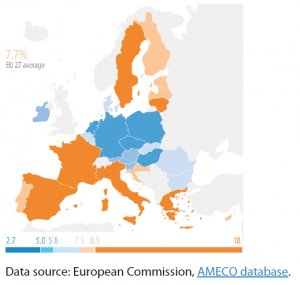A combination of government interventions and limited mobility, but also changing behaviour out of fear of infection, put the brakes on several types of economic activity. This has placed the labour market under strain. The latest projections for the 2020 unemployment rate were 8.3 % for the euro area and 7.7 % for the EU. The various furlough schemes and other supportive policy measures were instrumental in keeping the rise in the unemployment rate moderate (in comparison with the drop in economic activity). These policy measures were supported by the new EU instrument for temporary support to mitigate unemployment risks in an emergency (SURE). Nevertheless, the picture is nuanced: mobility restrictions during the lock-down pushed many unemployed people out of the labour force, as they no longer complied with the requirements necessary to be defined as unemployed. The Commission notes that this change in labour participation affects the relationship between employment and the unemployment rate (the decline in the labour participation rate masks employment losses in the unemployment statistics). Going forward, the Commission notes that the slower reaction of labour markets to a potential economic rebound, the expiry of work schemes, the extent of the use of telework and the speed of reallocation of employees from severely hit sectors to more resilient ones, are all factors expected to contribute to an increase in the unemployment rate, which is expected to peak at 9.4 % in the euro area and 8.6 % in the EU in 2021, before slowly dropping to 8.9 % and 8.0 % respectively in 2022.
Despite being protected by government measures, aggregate labour income is set to decrease in 2020 as many companies defer decisions about employing new staff, or reduce working hours or staff numbers. Some segments of the workforce are likely to be affected more than others, with the incomes of lower-wage earners and younger cohorts showing greater vulnerability to downturns.








Be the first to write a comment.